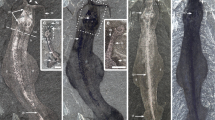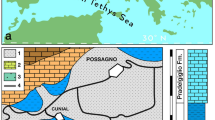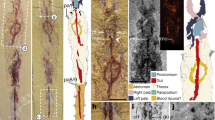Abstract
Anomalocaridids, giant lightly sclerotized invertebrate predators, occur in a number of exceptionally preserved early and middle Cambrian (542–501 million years ago) biotas and have come to symbolize the unfamiliar morphologies displayed by stem organisms in faunas of the Burgess Shale type. They are characterized by a pair of anterior, segmented appendages, a circlet of plates around the mouth, and an elongate segmented trunk lacking true tergites with a pair of flexible lateral lobes per segment1,2. Disarticulated body parts, such as the anterior appendages and oral circlet, had been assigned to a range of taxonomic groups—but the discovery of complete specimens from the middle Cambrian Burgess Shale showed that these disparate elements all belong to a single kind of animal3. Phylogenetic analyses support a position of anomalocaridids in the arthropod stem, as a sister group to the euarthropods4,5,6. The anomalocaridids were the largest animals in Cambrian communities. The youngest unequivocal examples occur in the middle Cambrian Marjum Formation of Utah7 but an arthropod retaining some anomalocaridid characteristics is present in the Devonian of Germany5. Here we report the post-Cambrian occurrence of anomalocaridids, from the Early Ordovician (488–472 million years ago) Fezouata Biota8 in southeastern Morocco, including specimens larger than any in Cambrian biotas. These giant animals were an important element of some marine communities for about 30 million years longer than previously realized. The Moroccan specimens confirm the presence of a dorsal array of flexible blades attached to a transverse rachis on the trunk segments; these blades probably functioned as gills.
This is a preview of subscription content, access via your institution
Access options
Subscribe to this journal
Receive 51 print issues and online access
$199.00 per year
only $3.90 per issue
Buy this article
- Purchase on Springer Link
- Instant access to full article PDF
Prices may be subject to local taxes which are calculated during checkout

Similar content being viewed by others
References
Chen, J. Y., Ramsköld, L. & Zhou, G. Q. Evidence for monophyly and arthropod affinity of Cambrian giant predators. Science 264, 1304–1308 (1994)
Collins, D. The “evolution” of Anomalocaris and its classification in the arthropod Class Dinocarida (nov.) and Order Radiodonta (nov.). J. Paleontol. 70, 280–293 (1996)
Whittington, H. B. & Briggs, D. E. G. The largest Cambrian animal, Anomalocaris, Burgess Shale, British Columbia. Phil. Trans. R. Soc. Lond. B 309, 569–609 (1985)
Budd, G. E. A Cambrian gilled lobopod from Greenland. Nature 364, 709–711 (1993)
Kühl, G., Briggs, D. E. G. & Rust, J. A great appendage arthropod with a radial mouth from the Lower Devonian Hunsrück Slate, Germany. Science 323, 771–773 (2009)
Daley, A. C., Budd, G. E., Caron, J.-B., Edgecombe, G. D. & Collins, D. The Burgess Shale anomalocaridid Hurdia and its significance for early euarthropod evolution. Science 323, 1597–1600 (2009)
Briggs, D. E. G. & Robison, R. A. Exceptionally preserved nontrilobite arthropods and Anomalocaris from the Middle Cambrian of Utah. Univ. Kansas Paleont. Contrib. 111, 1–23 (1984)
Van Roy, P. et al. Ordovician faunas of Burgess Shale type. Nature 465, 215–218 (2010)
Whiteaves, J. F. Description of a new genus and species of phyllocarid crustacean from the Middle Cambrian of Mount Stephen, British Columbia. Can. Rec. Sci. 5, 205–208 (1892)
Walcott, C. D. Middle Cambrian Merostomata. Cambrian geology and paleontology II. Smithson. Misc. Coll. 57, 17–40 (1911)
Walcott, C. D. Middle Cambrian Holothurians and Medusae. Cambrian geology and paleontology II. Smithson. Misc. Coll. 57, 41–68 (1911)
Walcott, C. D. Middle Cambrian Branchiopoda, Malacostraca, Trilobita, and Merostomata. Cambrian geology and paleontology II. Smithson. Misc. Coll. 57, 145–228 (1912)
Rolfe, W. D. I. Two new arthropod carapaces from the Burgess Shale (Middle Cambrian) of Canada. Breviora 160, 1–9 (1962)
Hou, X., Bergström, J. & Yang, J. Distinguishing anomalocaridids from arthropods and priapulids. Geol. J. 41, 259–269 (2006)
Chen, J., Waloszek, D. & Maas, A. A new 'great-appendage' arthropod from the Lower Cambrian of China and homology of chelicerate chelicerae and raptorial antero-ventral appendages. Lethaia 37, 3–20 (2004)
Dzik, J. & Lendzion, K. The oldest arthropods of the East European platform. Lethaia 21, 29–38 (1988)
Daley, A. C. & Budd, G. E. New anomalocaridid appendages from the Burgess Shale, Canada. Palaeontology 53, 721–738 (2010)
Ponomarenko, A. G. First record of Dinocarida from Russia. Paleontol. J. 44, 503–504 (2010)
Hou, X., Bergström, J. & Ahlberg, P. Anomalocaris and other large animals in the Lower Cambrian Chengjiang fauna of southwest China. Geol. För. Förh. 117, 163–183 (1995)
Daley, A. C. & Peel, J. S. A possible anomalocaridid from the Cambrian Sirius Passet Lagerstätte, north Greenland. J. Paleontol. 84, 352–355 (2010)
Masiak, M. & Zylinska, A. Burgess Shale-type fossils in Cambrian sandstones of the Holy Cross Mountains. Acta Palaeontol. Pol. 39, 329–340 (1994)
Van Roy, P. & Tetlie, O. E. A spinose appendage fragment of a problematic arthropod from the Early Ordovician of Morocco. Acta Palaeontol. Pol. 51, 239–246 (2006)
Vinther, J., Van Roy, P. & Briggs, D. E. G. Machaeridians are Palaeozoic armoured annelids. Nature 451, 185–188 (2008)
Fortey, R. A. A new giant asaphid trilobite from the Lower Ordovician of Morocco. Mem. Assoc. Austral. Palaeontol. 37, 9–16 (2009)
Bergström, J. Opabinia and Anomalocaris, unique Cambrian ‘arthropods’. Lethaia 19, 241–246 (1986)
Bergström, J. The Cambrian Opabinia and Anomalocaris . Lethaia 20, 187–188 (1987)
Budd, G. E. & Daley, A. C. The lobes and lobopods of Opabinia regalis of the middle Cambrian Burgess Shale. Lethaia (in the press)
Braddy, S. J., Poschmann, M. & Tetlie, O. E. Giant claw reveals the largest ever arthropod. Biol. Lett. 4, 106–109 (2008)
Hahn, G., Hahn, R. A. & Brauckmann, C. Zur Kenntis von Arthropleura (Myriapoda; Ober Karbon). Geol. Paleontol. 20, 125–137 (1986)
Servais, T., Owen, A. W., Harper, D. A. T., Kröger, B. & Munnecke, A. The Great Ordovician Biodiversification Event (GOBE): the palaeoecological dimension. Palaeogeogr. Palaeoclimatol. Palaeoecol. 294, 99–119 (2010)
Acknowledgements
S. Butts (Yale Peabody Museum of Natural History) provided access to specimens. M. Ben Said Ben Moula originally discovered the specimens and made them available for study; he, together with J. P. Botting-Muir and L. A. Botting-Muir, P. J. Orr, C. Upton and J. Vinther also assisted with fieldwork, and B. Tahiri arranged logistical support. J. W. Hagadorn shared information on anomalocaridid size and R. R. Gaines discussed aspects of the taphonomy. E. Champion helped with the preparation of figures. This research was supported by a National Geographic Society Research and Exploration grant and by Yale University.
Author information
Authors and Affiliations
Contributions
The authors contributed equally to interpreting the fossils and writing the paper. P.V.R. played the primary role in field work, and prepared, photographed and drew the specimens.
Corresponding author
Ethics declarations
Competing interests
The authors declare no competing financial interests.
Supplementary information
Supplementary Figures
This file contains Supplementary Figures 1-4 with legends. (PDF 11213 kb)
PowerPoint slides
Rights and permissions
About this article
Cite this article
Van Roy, P., Briggs, D. A giant Ordovician anomalocaridid. Nature 473, 510–513 (2011). https://doi.org/10.1038/nature09920
Received:
Accepted:
Published:
Issue Date:
DOI: https://doi.org/10.1038/nature09920
This article is cited by
-
New fossil assemblages from the Early Ordovician Fezouata Biota
Scientific Reports (2022)
-
Ordovician-Cambrian Palaeontological Heritage of Zagora Province: A Bibliometric Analysis from 1984 to 2020 (Anti-Atlas, Morocco)
Geoheritage (2022)
-
The functional head of the Cambrian radiodontan (stem-group Euarthropoda) Amplectobelua symbrachiata
BMC Evolutionary Biology (2017)
-
An acercostracan marrellomorph (Euarthropoda) from the Lower Ordovician of Morocco
The Science of Nature (2016)
-
Anomalocaridid trunk limb homology revealed by a giant filter-feeder with paired flaps
Nature (2015)
Comments
By submitting a comment you agree to abide by our Terms and Community Guidelines. If you find something abusive or that does not comply with our terms or guidelines please flag it as inappropriate.



